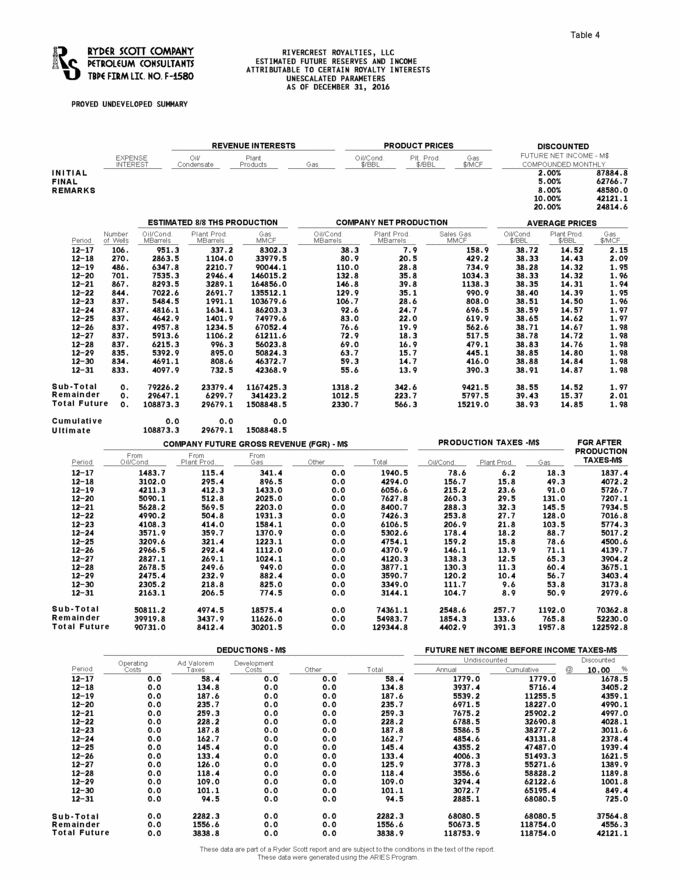Attached files
| file | filename |
|---|---|
| EX-99.2 - EX-99.2 - Kimbell Royalty Partners, LP | a17-8677_1ex99d2.htm |
| EX-32.2 - EX-32.2 - Kimbell Royalty Partners, LP | a17-8677_1ex32d2.htm |
| EX-32.1 - EX-32.1 - Kimbell Royalty Partners, LP | a17-8677_1ex32d1.htm |
| EX-31.2 - EX-31.2 - Kimbell Royalty Partners, LP | a17-8677_1ex31d2.htm |
| EX-31.1 - EX-31.1 - Kimbell Royalty Partners, LP | a17-8677_1ex31d1.htm |
| EX-23.8 - EX-23.8 - Kimbell Royalty Partners, LP | a17-8677_1ex23d8.htm |
| EX-23.7 - EX-23.7 - Kimbell Royalty Partners, LP | a17-8677_1ex23d7.htm |
| EX-21.1 - EX-21.1 - Kimbell Royalty Partners, LP | a17-8677_1ex21d1.htm |
| 10-K - 10-K - Kimbell Royalty Partners, LP | a17-8677_110k.htm |
Exhibit 99.1
Kimbell Royalty Partners, LP
Estimated
Future Reserves and Income
Attributable to Certain
Royalty Interests
SEC Parameters
As of
December 31, 2016
|
|
/s/ Scott J. Wilson |
|
|
|
Scott J. Wilson, P.E., MBA
RYDER SCOTT COMPANY, L.P. |
|
RYDER SCOTT COMPANY PETROLEUM CONSULTANTS
|
|
| ||
|
|
TBPE REGISTERED ENGINEERING FIRM F-1580 |
|
FAX (303) 623-4258 |
|
|
621 SEVENTEENTH STREET SUITE 1550 |
DENVER, COLORADO 80293 |
TELEPHONE (303) 623-9147 |
March 23, 2017
Kimbell Royalty Partners, LP
777 Taylor Street, Suite 810
Fort Worth, Texas 76102
Gentlemen:
At your request, Ryder Scott Company, L.P. (Ryder Scott) has prepared an estimate of the proved reserves, future production, and income attributable to certain royalty interests of Kimbell Royalty Partners, LP, (KRP) as of December 31, 2016. The diverse inventory of royalty interests are located primarily in the state of Texas, but with other interests in 20 other states. The reserves and income data were estimated based on the definitions and disclosure guidelines of the United States Securities and Exchange Commission (SEC) contained in Title 17, Code of Federal Regulations, Modernization of Oil and Gas Reporting, Final Rule released January 14, 2009 in the Federal Register (SEC regulations). Our third party study, completed on March 23, 2017 and presented herein, was prepared for public disclosure by KRP in filings made with the SEC in accordance with the disclosure requirements set forth in the SEC regulations.
The properties evaluated by Ryder Scott represent 100 percent of the total net proved liquid hydrocarbon reserves and 100 percent of the total net proved gas reserves of KRP as of December 31, 2016.
The estimated reserves and future net income amounts presented in this report, as of December 31, 2016, are related to hydrocarbon prices. The hydrocarbon prices used in the preparation of this report are based on the average prices during the 12-month period prior to the “as of date” of this report, determined as the unweighted arithmetic averages of the prices in effect on the first-day-of-the-month for each month within such period, unless prices were defined by contractual arrangements, as required by the SEC regulations. Actual future prices may vary significantly from the prices required by SEC regulations; therefore, volumes of reserves actually recovered and the amounts of income actually received may differ significantly from the estimated quantities presented in this report. The results of this study are summarized as follows.
|
1100 LOUISIANA, SUITE 4600 |
HOUSTON, TEXAS 77002-5218 |
TEL (713) 651-9191 |
FAX (713) 651-0849 |
|
1015 4TH STREET S.W. SUITE 600 |
CALGARY, ALBERTA T2R 1J4 |
TEL (403) 262-2799 |
FAX (403) 262-2790 |
Kimbell Royalty Partners, LP
March 23, 2017
Page 2
|
|
SEC PARAMETERS |
|
|
|
Estimated Net Reserves and Income Data |
|
|
|
Certain Royalty Interests of |
|
|
|
Kimbell Royalty Partners, LP |
|
|
|
As of December 31, 2016 |
|
|
|
|
Proved |
| ||||||
|
|
|
Developed |
|
|
|
Total |
| ||
|
|
|
Producing |
|
Non-Producing |
|
Undeveloped |
|
Proved |
|
|
Net Remaining Reserves |
|
|
|
|
|
|
|
|
|
|
Oil/Condensate – MBarrels |
|
4,836 |
|
43 |
|
2,331 |
|
7,210 |
|
|
Plant Products – MBarrels |
|
1,383 |
|
33 |
|
566 |
|
1,982 |
|
|
Gas – MMCF |
|
34,322 |
|
850 |
|
15,219 |
|
50,391 |
|
|
|
|
|
|
|
|
|
|
|
|
|
Income Data (M$) |
|
|
|
|
|
|
|
|
|
|
Future Gross Revenue |
|
$267,868 |
|
$3,217 |
|
$122,593 |
|
$393,678 |
|
|
Deductions |
|
7,802 |
|
67 |
|
3,839 |
|
11,708 |
|
|
Future Net Income (FNI) |
|
$260,066 |
|
$3,150 |
|
$118,754 |
|
$381,970 |
|
|
|
|
|
|
|
|
|
|
|
|
|
Discounted FNI @ 10% |
|
$117,800 |
|
$1,406 |
|
$ 42,121 |
|
$161,327 |
|
Liquid hydrocarbons are expressed in standard 42 gallon barrels and shown herein as thousands of barrels (MBarrels). All gas volumes are reported on an “as sold” basis expressed in millions of cubic feet (MMCF) at the official temperature and pressure bases of the areas in which the gas reserves are located. In this report, the revenues, deductions, and income data are expressed as thousands of U.S. dollars (M$).
The estimates of the reserves, future production, and income attributable to properties in this report were prepared using the economic software package ARIESTM Petroleum Economics and Reserves Software, a copyrighted program of Halliburton. Ryder Scott has found this program to be generally acceptable, but notes that certain summaries and calculations may vary due to rounding and may not exactly match the sum of the properties being summarized. Furthermore, one line economic summaries may vary slightly from the more detailed cash flow projections of the same properties, also due to rounding. The rounding differences are not material.
The future gross revenue is after the deduction of production taxes. Since the evaluation includes only royalty interests there are only deductions for ad valorem taxes, while the normal direct costs of operating the wells, recompletion costs, and development costs are used only to estimate economic lives. The future net income is before the deduction of general administrative overhead, and has not been adjusted for outstanding loans that may exist nor does it include any adjustment for cash on hand or undistributed income.
Liquid hydrocarbon reserves account for approximately 75 percent and gas reserves account for the remaining 25 percent of total future gross revenue from proved reserves.
The discounted future net income shown above was calculated using a discount rate of 10 percent per annum compounded monthly. Future net income was discounted at four other discount rates which were also compounded monthly. These results are shown in summary form as follows.
RYDER SCOTT COMPANY PETROLEUM CONSULTANTS
Kimbell Royalty Partners, LP
March 23, 2017
Page 3
|
|
|
Discounted Future Net Income (M$) |
|
|
|
|
As of December 31, 2016 |
|
|
Discount Rate |
|
Total |
|
|
Percent |
|
Proved |
|
|
|
|
|
|
|
2 |
|
$298,120 |
|
|
5 |
|
$225,220 |
|
|
8 |
|
$181,732 |
|
|
20 |
|
$104,744 |
|
The results shown above are presented for your information and should not be construed as our estimate of fair market value.
Reserves Included in This Report
The proved reserves included herein conform to the definitions as set forth in the Securities and Exchange Commission’s Regulations Part 210.4-10(a). An abridged version of the SEC reserves definitions from 210.4-10(a) entitled “Petroleum Reserves Definitions” is included as an attachment to this report.
The various reserve status categories are defined under the attachment entitled “Petroleum Reserves Status Definitions and Guidelines” in this report. The proved developed non-producing reserves included herein consist of the shut-in and behind pipe categories.
No attempt was made to quantify or otherwise account for any accumulated gas production imbalances that may exist. The proved gas volumes presented herein do not include volumes of gas consumed in operations as reserves.
Reserves are “estimated remaining quantities of oil and gas and related substances anticipated to be economically producible, as of a given date, by application of development projects to known accumulations.” All reserve estimates involve an assessment of the uncertainty relating the likelihood that the actual remaining quantities recovered will be greater or less than the estimated quantities determined as of the date the estimate is made. The uncertainty depends chiefly on the amount of reliable geologic and engineering data available at the time of the estimate and the interpretation of these data. The relative degree of uncertainty may be conveyed by placing reserves into one of two principal classifications, either proved or unproved. Unproved reserves are less certain to be recovered than proved reserves and may be further sub-classified as probable and possible reserves to denote progressively increasing uncertainty in their recoverability. At KRP’s request, this report addresses only the proved reserves attributable to the properties evaluated herein.
Proved oil and gas reserves are “those quantities of oil and gas which, by analysis of geoscience and engineering data, can be estimated with reasonable certainty to be economically producible from a given date forward.” The proved reserves included herein were estimated using deterministic methods. The SEC has defined reasonable certainty for proved reserves, when based on deterministic methods, as a “high degree of confidence that the quantities will be recovered.”
Reserve estimates will generally be revised only as additional geologic or engineering data become available or as economic conditions change. For proved reserves, the SEC states that “as changes due to increased availability of geoscience (geological, geophysical, and geochemical), engineering, and economic data are made to the estimated ultimate recovery (EUR) with time,
RYDER SCOTT COMPANY PETROLEUM CONSULTANTS
Kimbell Royalty Partners, LP
March 23, 2017
Page 4
reasonably certain EUR is much more likely to increase or remain constant than to decrease.” Moreover, estimates of proved reserves may be revised as a result of future operations, effects of regulation by governmental agencies or geopolitical or economic risks. Therefore, the proved reserves included in this report are estimates only and should not be construed as being exact quantities, and if recovered, the revenues therefrom, and the actual costs related thereto, could be more or less than the estimated amounts.
KRP’s operations may be subject to various levels of governmental controls and regulations. These controls and regulations may include, but may not be limited to, matters relating to land tenure and leasing, the legal rights to produce, drilling and production practices, environmental protection, marketing and pricing policies, royalties, various taxes and levies including income tax, and are subject to change from time to time. Such changes in governmental regulations and policies may cause volumes of proved reserves actually recovered and amounts of proved income actually received to differ significantly from the estimated quantities.
The estimates of proved reserves presented herein were based upon a detailed study of the properties in which KRP owns a royalty interest; however, we have not made any field examination of the properties. No consideration was given in this report to potential environmental liabilities that may exist nor were any costs included for potential liabilities to restore and clean up damages, if any, caused by past operating practices.
Estimates of Reserves
The estimation of reserves involves two distinct determinations. The first determination results in the estimation of the quantities of recoverable oil and gas and the second determination results in the estimation of the uncertainty associated with those estimated quantities in accordance with the definitions set forth by the Securities and Exchange Commission’s Regulations Part 210.4-10(a). The process of estimating the quantities of recoverable oil and gas reserves relies on the use of certain generally accepted analytical procedures. These analytical procedures fall into three broad categories or methods: (1) performance-based methods, (2) volumetric-based methods and (3) analogy. These methods may be used individually or in combination by the reserve evaluator in the process of estimating the quantities of reserves. Reserve evaluators must select the method or combination of methods which in their professional judgment is most appropriate given the nature and amount of reliable geoscience and engineering data available at the time of the estimate, the established or anticipated performance characteristics of the reservoir being evaluated, and the stage of development or producing maturity of the property.
In many cases, the analysis of the available geoscience and engineering data and the subsequent interpretation of this data may indicate a range of possible outcomes in an estimate, irrespective of the method selected by the evaluator. When a range in the quantity of reserves is identified, the evaluator must determine the uncertainty associated with the incremental quantities of the reserves. If the reserve quantities are estimated using the deterministic incremental approach, the uncertainty for each discrete incremental quantity of the reserves is addressed by the reserve category assigned by the evaluator. Therefore, it is the categorization of reserve quantities as proved, probable and/or possible that addresses the inherent uncertainty in the estimated quantities reported. For proved reserves, uncertainty is defined by the SEC as reasonable certainty wherein the “quantities actually recovered are much more likely than not to be achieved.” The SEC states that “probable reserves are those additional reserves that are less certain to be recovered than proved reserves but which, together with proved reserves, are as likely as not to be recovered.” The SEC states that “possible reserves are those additional reserves that are less certain to be recovered than probable
RYDER SCOTT COMPANY PETROLEUM CONSULTANTS
Kimbell Royalty Partners, LP
March 23, 2017
Page 5
reserves and the total quantities ultimately recovered from a project have a low probability of exceeding proved plus probable plus possible reserves.” All quantities of reserves within the same reserve category must meet the SEC definitions as noted above.
Estimates of reserves quantities and their associated reserve categories may be revised in the future as additional geoscience or engineering data become available. Furthermore, estimates of reserves quantities and their associated reserve categories may also be revised due to other factors such as changes in economic conditions, results of future operations, effects of regulation by governmental agencies or geopolitical or economic risks as previously noted herein.
The proved reserves for the properties included herein were estimated by performance methods or analogy. One hundred percent of the proved producing reserves attributable to producing wells and/or reservoirs were estimated by performance methods. These performance methods include decline curve analysis which utilized extrapolations of historical production and pressure data available through December 2016 in those cases where such data were and considered to be definitive. The data utilized in this analysis were furnished to Ryder Scott by KRP and were considered sufficient for the purpose thereof.
One hundred percent of the proved developed non-producing and undeveloped reserves included herein were estimated by analogy. The data utilized from the analogues were considered sufficient for the purpose thereof.
To estimate economically recoverable proved oil and gas reserves and related future net cash flows, we consider many factors and assumptions including, but not limited to, the use of reservoir parameters derived from geological, geophysical and engineering data which cannot be measured directly, economic criteria based on current costs and SEC pricing requirements, and forecasts of future production rates. Under the SEC regulations 210.4-10(a)(22)(v) and (26), proved reserves must be anticipated to be economically producible from a given date forward based on existing economic conditions including the prices and costs at which economic producibility from a reservoir is to be determined. While it may reasonably be anticipated that the future prices received for the sale of production and the operating costs and other costs relating to such production may increase or decrease from those under existing economic conditions, such changes were, in accordance with rules adopted by the SEC, omitted from consideration in making this evaluation.
KRP has informed us that they have furnished us all of the material accounts, records, geological and engineering data, and reports and other data required for this investigation. In preparing our forecast of future proved production and income, we have relied upon data furnished by KRP with respect to property interests owned, production and well tests from examined wells, normal direct costs of operating the wells or leases, other costs such as transportation and/or processing fees, ad valorem and production taxes, recompletion and development costs, development plans, abandonment costs after salvage, product prices based on the SEC regulations, adjustments or differentials to product prices, geological structural and isochore maps, well logs, core analyses, and pressure measurements. Ryder Scott reviewed such factual data for its reasonableness; however, we have not conducted an independent verification of the data furnished by KRP. We consider the factual data used in this report appropriate and sufficient for the purpose of preparing the estimates of reserves and future net revenues herein.
In summary, we consider the assumptions, data, methods and analytical procedures used in this report appropriate for the purpose hereof, and we have used all such methods and procedures that we consider necessary and appropriate to prepare the estimates of reserves herein. The proved reserves included herein were determined in conformance with the United States Securities and
RYDER SCOTT COMPANY PETROLEUM CONSULTANTS
Kimbell Royalty Partners, LP
March 23, 2017
Page 6
Exchange Commission (SEC) Modernization of Oil and Gas Reporting; Final Rule, including all references to Regulation S-X and Regulation S-K, referred to herein collectively as the “SEC Regulations.” In our opinion, the proved reserves presented in this report comply with the definitions, guidelines and disclosure requirements as required by the SEC regulations.
Future Production Rates
For wells currently on production, our forecasts of future production rates are based on historical performance data. If no production decline trend has been established, future production rates were held constant, or adjusted for the effects of curtailment where appropriate, until a decline in ability to produce was anticipated. An estimated rate of decline was then applied to depletion of the reserves. If a decline trend has been established, this trend was used as the basis for estimating future production rates.
Test data and other related information were used to estimate the anticipated initial production rates for those wells or locations that are not currently producing. For reserves not yet on production, sales were estimated to commence at an anticipated date furnished by KRP. Wells or locations that are not currently producing may start producing earlier or later than anticipated in our estimates due to unforeseen factors causing a change in the timing to initiate production. Such factors may include delays due to weather, the availability of rigs, the sequence of drilling, completing and/or recompleting wells and/or constraints set by regulatory bodies.
The future production rates from wells currently on production or wells or locations that are not currently producing may be more or less than estimated because of changes including, but not limited to, reservoir performance, operating conditions related to surface facilities, compression and artificial lift, pipeline capacity and/or operating conditions, producing market demand and/or allowables or other constraints set by regulatory bodies.
Hydrocarbon Prices
The hydrocarbon prices used herein are based on SEC price parameters using the average prices during the 12-month period prior to the “as of date” of this report, determined as the unweighted arithmetic averages of the prices in effect on the first-day-of-the-month for each month within such period, unless prices were defined by contractual arrangements. For hydrocarbon products sold under contract, the contract prices, including fixed and determinable escalations, exclusive of inflation adjustments, were used until expiration of the contract. Upon contract expiration, the prices were adjusted to the 12-month unweighted arithmetic average as previously described.
KRP furnished us with the above mentioned average prices in effect on December 31, 2016. These initial SEC hydrocarbon prices were determined using the 12-month average first-day-of-the-month benchmark prices appropriate to the geographic area where the hydrocarbons are sold. These benchmark prices are prior to the adjustments for differentials as described herein. The table below summarizes the “benchmark prices” and “price reference” used for the geographic area included in the report. In certain geographic areas, the price reference and benchmark prices may be defined by contractual arrangements
The product prices which were actually used to determine the future gross revenue for each property reflect adjustments to the benchmark prices for gravity, quality, local conditions, and/or distance from market, referred to herein as “differentials.” The differentials used in the preparation of
RYDER SCOTT COMPANY PETROLEUM CONSULTANTS
Kimbell Royalty Partners, LP
March 23, 2017
Page 7
this report were furnished to us by KRP. The differentials furnished to us were accepted as factual data and reviewed by us for their reasonableness; however, we have not conducted an independent verification of the data used by KRP to determine these differentials.
In addition, the table below summarizes the net volume weighted benchmark prices adjusted for differentials and referred to herein as the “average realized prices.” The average realized prices shown in the table below were determined from the total future gross revenue before production taxes and the total net reserves for the geographic area and presented in accordance with SEC disclosure requirements for each of the geographic areas included in the report.
|
Geographic Area |
|
|
Product |
|
|
Price |
|
|
Average |
|
|
Average |
|
North America |
|
|
|
|
|
|
|
|
|
|
|
|
|
United States |
|
|
Oil/Condensate |
|
|
WTI Cushing |
|
|
$42.75/BBL |
|
|
$39.23/BBL |
|
|
|
Plant Products |
|
|
WTI Cushing |
|
|
$42.75/BBL |
|
|
$14.91/BBL | |
|
|
|
Gas |
|
|
Henry Hub |
|
|
$2.49/MMBTU |
|
|
$2.02/MCF |
The effects of derivative instruments designated as price hedges of oil and gas quantities are not reflected in our individual property evaluations.
Costs
Estimated operating costs for the leases and wells in this report were furnished by KRP and are based on the operating expense reports of the operators of the properties and include only those costs directly applicable to the leases or wells. Because these are not working interests, no operating costs are included for KRP’s interests, but are considered in estimates to accurately reflect economic lives of each entity. The operating costs furnished to us were accepted as factual data and reviewed by us for their reasonableness; however, we have not conducted an independent verification of the operating cost data used by KRP. No deduction was made for loan repayments, interest expenses, or exploration and development prepayments that were not charged directly to the leases or wells.
Development costs were not incorporated into these cash flows since KRP does not own working interests. Typical development costs were considered when reviewing the estimates of undeveloped inventory which includes new development in basins with a historical record of continuous development and used similarly as the operating costs in determining these are economically recoverable reserves.
The proved developed non-producing and undeveloped reserves in this report have been incorporated herein in accordance with KRP’s estimates of the operator’s expectations to develop these reserves as of December 31, 2016. Development activities are subject to specific operator and partner AFE processes, Joint Operating Agreement (JOA) requirements or other administrative approvals external to KRP. Additionally, KRP has informed us that they are not aware of any legal, regulatory, or political obstacles that would significantly alter their estimates of development plans. While these plans could change from those under existing economic conditions as of December 31, 2016, such changes were, in accordance with rules adopted by the SEC, omitted from consideration in making this evaluation.
RYDER SCOTT COMPANY PETROLEUM CONSULTANTS
Kimbell Royalty Partners, LP
March 23, 2017
Page 8
Current costs used by KRP were held constant throughout the life of the properties.
Standards of Independence and Professional Qualification
Ryder Scott is an independent petroleum engineering consulting firm that has been providing petroleum consulting services throughout the world since 1937. Ryder Scott is employee-owned and maintains offices in Houston, Texas; Denver, Colorado; and Calgary, Alberta, Canada. We have over eighty engineers and geoscientists on our permanent staff. By virtue of the size of our firm and the large number of clients for which we provide services, no single client or job represents a material portion of our annual revenue. We do not serve as officers or directors of any privately-owned or publicly-traded oil and gas company and are separate and independent from the operating and investment decision-making process of our clients. This allows us to bring the highest level of independence and objectivity to each engagement for our services.
Ryder Scott actively participates in industry-related professional societies and organizes an annual public forum focused on the subject of reserves evaluations and SEC regulations. Many of our staff have authored or co-authored technical papers on the subject of reserves related topics. We encourage our staff to maintain and enhance their professional skills by actively participating in ongoing continuing education.
Prior to becoming an officer of the Company, Ryder Scott requires that staff engineers and geoscientists have received professional accreditation in the form of a registered or certified professional engineer’s license or a registered or certified professional geoscientist’s license, or the equivalent thereof, from an appropriate governmental authority or a recognized self-regulating professional organization.
We are independent petroleum engineers with respect to KRP. Neither we nor any of our employees have any financial interest in the subject properties and neither the employment to do this work nor the compensation is contingent on our estimates of reserves for the properties which were reviewed.
The results of this study, presented herein, are based on technical analysis conducted by teams of geoscientists and engineers from Ryder Scott. The professional qualifications of the undersigned, the technical person primarily responsible for overseeing the evaluation of the reserves information discussed in this report, are included as an attachment to this letter.
Terms of Usage
The results of our third party study, presented in report form herein, were prepared in accordance with the disclosure requirements set forth in the SEC regulations and intended for public disclosure as an exhibit in filings made with the SEC.
We have provided KRP with a digital version of the original signed copy of this report letter. In the event there are any differences between the digital version included in filings made by KRP and the original signed report letter, the original signed report letter shall control and supersede the digital version.
RYDER SCOTT COMPANY PETROLEUM CONSULTANTS
Kimbell Royalty Partners, LP
March 23, 2017
Page 9
The data and work papers used in the preparation of this report are available for examination by authorized parties in our offices. Please contact us if we can be of further service.
|
|
Very truly yours, | |
|
|
| |
|
|
RYDER SCOTT COMPANY, L.P. | |
|
|
TBPE Firm Registration No. F-1580 | |
|
|
| |
|
|
/s/ Scott James Wilson |
|
|
SJW (FWZ)/pl |
Scott J. Wilson, P.E., MBA |
|
RYDER SCOTT COMPANY PETROLEUM CONSULTANTS
Professional Qualifications of Primary Technical Person
The conclusions presented in this report are the result of technical analysis conducted by teams of geoscientists and engineers from Ryder Scott Company, L.P. Mr. Scott James Wilson was the primary technical person responsible for the estimate of the reserves, future production, and income presented herein.
Mr. Wilson, an employee of Ryder Scott Company, L.P. (Ryder Scott) since 2000, is a Senior Vice President responsible for coordinating and supervising staff and consulting engineers of the company in ongoing reservoir evaluation studies worldwide. Before joining Ryder Scott, Mr. Wilson served in a number of engineering positions with Atlantic Richfield Company. For more information regarding Mr. Wilson’s geographic and job specific experience, please refer to the Ryder Scott Company website at http://www.ryderscott.com/Experience/Employees.
Mr. Wilson earned a Bachelor of Science degree in Petroleum Engineering from the Colorado School of Mines in 1983 and an MBA in Finance from the University of Colorado in 1985, graduating from both with High Honors. He is a registered Professional Engineer by exam in the States of Alaska, Colorado, Texas and Wyoming. He is also an active member of the Society of Petroleum Engineers; serving as co-Chairman of the SPE Reserves and Economics Technology Interest Group, and Gas Technology Editor for SPE’s Journal of Petroleum Technology. He is a member and past chairman of the Denver section of the Society of Petroleum Evaluation Engineers. Mr. Wilson has published several technical papers and is the primary inventor of three US patents.
In addition to gaining experience and competency through prior work experience, the Wyoming Board of Professional Engineers requires a minimum of fifteen hours of continuing education annually, including at least one hour in the area of professional ethics, which Mr. Wilson fulfills. As part of his continuing education hours, Mr. Wilson attended an internally presented sixteen hours of formalized training as well as a public forum relating to the definitions and disclosure guidelines contained in the United States Securities and Exchange Commission Title 17, Code of Federal Regulations, Modernization of Oil and Gas Reporting, Final Rule released January 14, 2009 in the Federal Register. Mr. Wilson attended additional hours of formalized external training covering such topics as the SPE/WPC/AAPG/SPEE Petroleum Resources Management System, reservoir engineering and petroleum economics evaluation methods, procedures and software and ethics for consultants.
Based on his educational background, professional training and more than 30 years of practical experience in the estimation and evaluation of petroleum reserves, Mr. Wilson has attained the professional qualifications as a Reserves Estimator and Reserves Auditor set forth in Article III of the “Standards Pertaining to the Estimating and Auditing of Oil and Gas Reserves Information” promulgated by the Society of Petroleum Engineers as of February 19, 2007.
RYDER SCOTT COMPANY PETROLEUM CONSULTANTS
PETROLEUM RESERVES DEFINITIONS As Adapted From: RULE 4-10(a) of REGULATION S-X PART 210 UNITED STATES SECURITIES AND EXCHANGE COMMISSION (SEC) PREAMBLE On January 14, 2009, the United States Securities and Exchange Commission (SEC) published the “Modernization of Oil and Gas Reporting; Final Rule” in the Federal Register of National Archives and Records Administration (NARA). The “Modernization of Oil and Gas Reporting; Final Rule” includes revisions and additions to the definition section in Rule 4-10 of Regulation S-X, revisions and additions to the oil and gas reporting requirements in Regulation S-K, and amends and codifies Industry Guide 2 in Regulation S-K. The “Modernization of Oil and Gas Reporting; Final Rule”, including all references to Regulation S-X and Regulation S-K, shall be referred to herein collectively as the “SEC regulations”. The SEC regulations take effect for all filings made with the United States Securities and Exchange Commission as of December 31, 2009, or after January 1, 2010. Reference should be made to the full text under Title 17, Code of Federal Regulations, Regulation S-X Part 210, Rule 4-10(a) for the complete definitions (direct passages excerpted in part or wholly from the aforementioned SEC document are denoted in italics herein). Reserves are estimated remaining quantities of oil and gas and related substances anticipated to be economically producible, as of a given date, by application of development projects to known accumulations. All reserve estimates involve an assessment of the uncertainty relating the likelihood that the actual remaining quantities recovered will be greater or less than the estimated quantities determined as of the date the estimate is made. The uncertainty depends chiefly on the amount of reliable geologic and engineering data available at the time of the estimate and the interpretation of these data. The relative degree of uncertainty may be conveyed by placing reserves into one of two principal classifications, either proved or unproved. Unproved reserves are less certain to be recovered than proved reserves and may be further sub-classified as probable and possible reserves to denote progressively increasing uncertainty in their recoverability. Under the SEC regulations as of December 31, 2009, or after January 1, 2010, a company may optionally disclose estimated quantities of probable or possible oil and gas reserves in documents publicly filed with the SEC. The SEC regulations continue to prohibit disclosure of estimates of oil and gas resources other than reserves and any estimated values of such resources in any document publicly filed with the SEC unless such information is required to be disclosed in the document by foreign or state law as noted in §229.1202 Instruction to Item 1202. Reserves estimates will generally be revised only as additional geologic or engineering data become available or as economic conditions change. Reserves may be attributed to either natural energy or improved recovery methods. Improved recovery methods include all methods for supplementing natural energy or altering natural forces in the reservoir to increase ultimate recovery. Examples of such methods are pressure maintenance, natural gas cycling, water flooding, thermal methods, chemical flooding, and the use of miscible and immiscible displacement fluids. Other improved recovery methods may be developed in the future as petroleum technology continues to evolve. Reserves may be attributed to either conventional or unconventional petroleum accumulations. Petroleum accumulations are considered as either conventional or unconventional based on the nature of their in-place characteristics, extraction method applied, or degree of processing prior to sale. RYDER SCOTT COMPANY PETR OLEUM CONSULTANTS
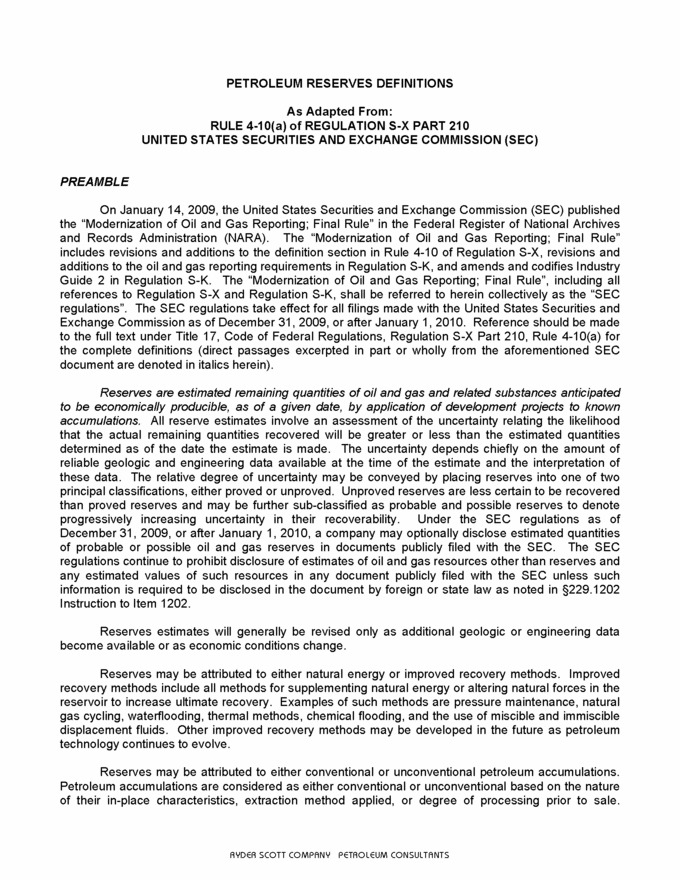
PETROLEUM RESERVES DEFINITIONS Page Examples of unconventional petroleum accumulations include coalbed or coal seam methane (CBM/CSM), basin-centered gas, shale gas, gas hydrates, natural bitumen and oil shale deposits. These unconventional accumulations may require specialized extraction technology and/or significant processing prior to sale. Reserves do not include quantities of petroleum being held in inventory. Because of the differences in uncertainty, caution should be exercised when aggregating quantities of petroleum from different reserves categories. RESERVES (SEC DEFINITIONS) Securities and Exchange Commission Regulation S-X §210.4-10(a) (26) defines reserves as follows: Reserves. Reserves are estimated remaining quantities of oil and gas and related substances anticipated to be economically producible, as of a given date, by application of development projects to known accumulations. In addition, there must exist, or there must be a reasonable expectation that there will exist, the legal right to produce or a revenue interest in the production, installed means of delivering oil and gas or related substances to market, and all permits and financing required to implement the project. Note to paragraph (a) (26): Reserves should not be assigned to adjacent reservoirs isolated by major, potentially sealing, faults until those reservoirs are penetrated and evaluated as economically producible. Reserves should not be assigned to areas that are clearly separated from a known accumulation by a non-productive reservoir (i.e., absence of reservoir, structurally low reservoir, or negative test results). Such areas may contain prospective resources (i.e., potentially recoverable resources from undiscovered accumulations). PROVED RESERVES (SEC DEFINITIONS) Securities and Exchange Commission Regulation S-X §210.4-10(a) (22) defines proved oil and gas reserves as follows: Proved oil and gas reserves. Proved oil and gas reserves are those quantities of oil and gas, which, by analysis of geoscience and engineering data, can be estimated with reasonable certainty to be economically producible—from a given date forward, from known reservoirs, and under existing economic conditions, operating methods, and government regulations—prior to the time at which contracts providing the right to operate expire, unless evidence indicates that renewal is reasonably certain, regardless of whether deterministic or probabilistic methods are used for the estimation. The project to extract the hydrocarbons must have commenced or the operator must be reasonably certain that it will commence the project within a reasonable time. (i) The area of the reservoir considered as proved includes: (A) The area identified by drilling and limited by fluid contacts, if any, and (B) Adjacent undrilled portions of the reservoir that can, with reasonable certainty, be judged to be continuous with it and to contain economically producible oil or gas on the basis of available geoscience and engineering data. RYDER SCOTT COMPANY PETR OLEUM CONSULTANTS
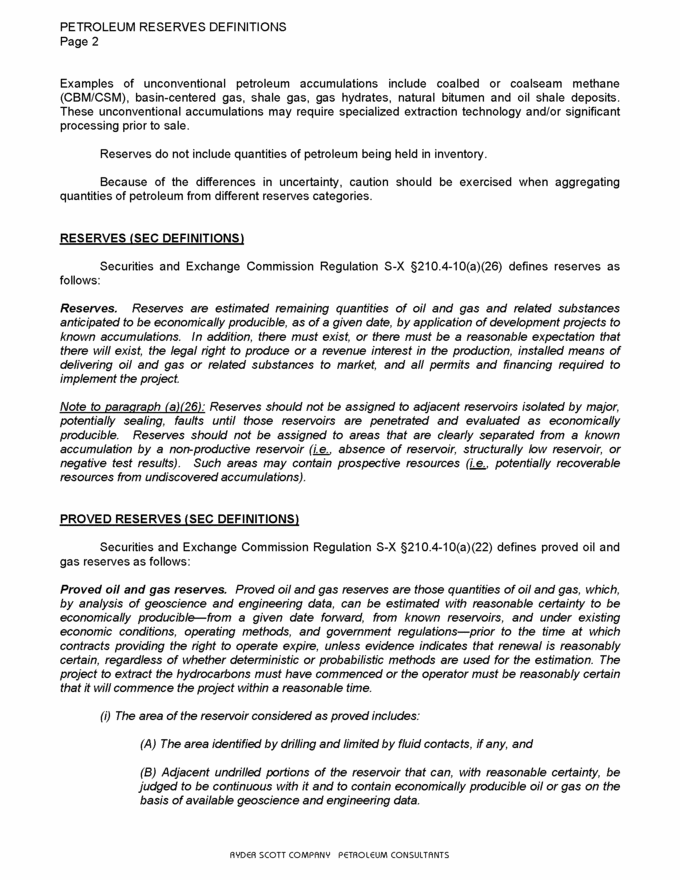
PETROLEUM RESERVES DEFINITIONS Page PROVED RESERVES (SEC DEFINITIONS) CONTINUED (ii) In the absence of data on fluid contacts, proved quantities in a reservoir are limited by the lowest known hydrocarbons (LKH) as seen in a well penetration unless geoscience, engineering, or performance data and reliable technology establishes a lower contact with reasonable certainty. (iii) Where direct observation from well penetrations has defined a highest known oil (HKO) elevation and the potential exists for an associated gas cap, proved oil reserves may be assigned in the structurally higher portions of the reservoir only if geoscience, engineering, or performance data and reliable technology establish the higher contact with reasonable certainty. (iv) Reserves which can be produced economically through application of improved recovery techniques (including, but not limited to, fluid injection) are included in the proved classification when: (A) Successful testing by a pilot project in an area of the reservoir with properties no more favorable than in the reservoir as a whole, the operation of an installed program in the reservoir or an analogous reservoir, or other evidence using reliable technology establishes the reasonable certainty of the engineering analysis on which the project or program was based; and (B) The project has been approved for development by all necessary parties and entities, including governmental entities. (v) Existing economic conditions include prices and costs at which economic reducibility from a reservoir is to be determined. The price shall be the average price during the 12-month period prior to the ending date of the period covered by the report, determined as an unweighted arithmetic average of the first-day-of-the-month price for each month within such period, unless prices are defined by contractual arrangements, excluding escalations based upon future conditions. RYDER SCOTT COMPANY PETR OLEUM CONSULTANTS
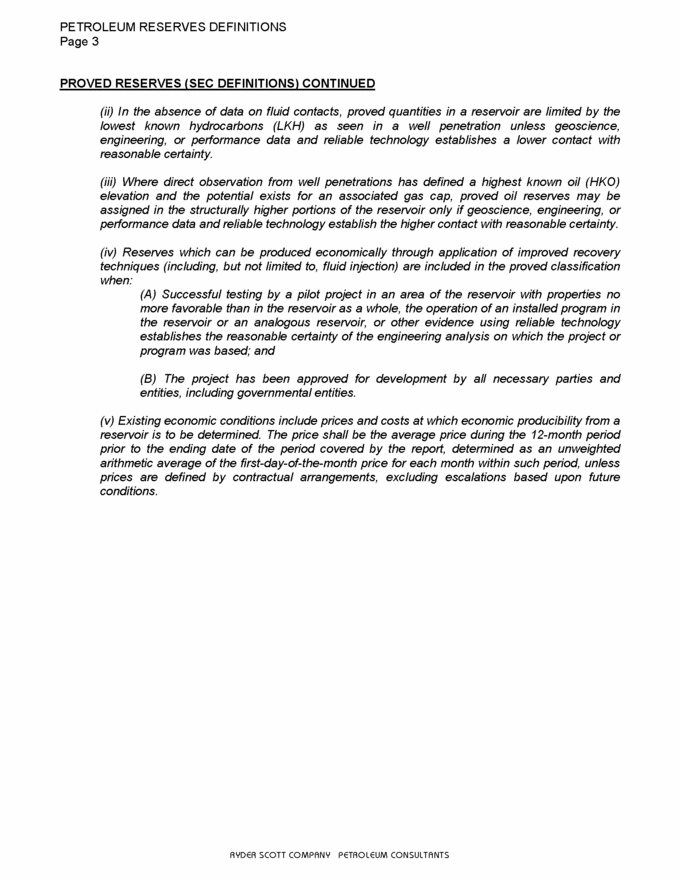
PETROLEUM RESERVES STATUS DEFINITIONS AND GUIDELINES As Adapted From: RULE 4-10(a) of REGULATION S-X PART 210 UNITED STATES SECURITIES AND EXCHANGE COMMISSION (SEC) and PETROLEUM RESOURCES MANAGEMENT SYSTEM (SPE-PRMS) Sponsored and Approved by: SOCIETY OF PETROLEUM ENGINEERS (SPE) WORLD PETROLEUM COUNCIL (WPC) AMERICAN ASSOCIATION OF PETROLEUM GEOLOGISTS (AAPG) SOCIETY OF PETROLEUM EVALUATION ENGINEERS (SPEE) Reserves status categories define the development and producing status of wells and reservoirs. Reference should be made to Title 17, Code of Federal Regulations, Regulation S-X Part 210, Rule 4-10(a) and the SPE-PRMS as the following reserves status definitions are based on excerpts from the original documents (direct passages excerpted from the aforementioned SEC and SPE-PRMS documents are denoted in italics herein). DEVELOPED RESERVES (SEC DEFINITIONS) Securities and Exchange Commission Regulation S-X §210.4-10(a)(6) defines developed oil and gas reserves as follows: Developed oil and gas reserves are reserves of any category that can be expected to be recovered: (i) Through existing wells with existing equipment and operating methods or in which the cost of the required equipment is relatively minor compared to the cost of a new well; and (ii) Through installed extraction equipment and infrastructure operational at the time of the reserves estimate if the extraction is by means not involving a well. Developed Producing (SPE-PRMS Definitions) While not a requirement for disclosure under the SEC regulations, developed oil and gas reserves may be further sub-classified according to the guidance contained in the SPE-PRMS as Producing or Non-Producing. Developed Producing Reserves Developed Producing Reserves are expected to be recovered from completion intervals that are open and producing at the time of the estimate. Improved recovery reserves are considered producing only after the improved recovery project is in operation. RYDER SCOTT COMPANY PETR OLEUM CONSULTANTS
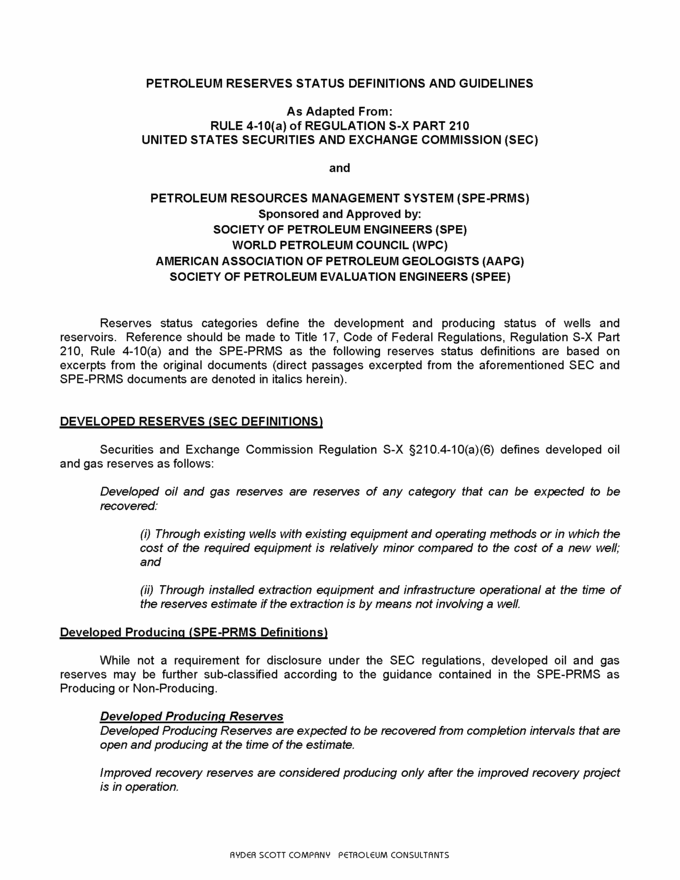
PETROLEUM RESERVES STATUS DEFINITIONS AND GUIDELINES Page 2 Developed Non-Producing Developed Non-Producing Reserves include shut-in and behind-pipe reserves. Shut-In Shut-in Reserves are expected to be recovered from: (1) completion intervals which are open at the time of the estimate, but which have not started producing; (2) wells which were shut-in for market conditions or pipeline connections; or (3) wells not capable of production for mechanical reasons. Behind-Pipe Behind-pipe Reserves are expected to be recovered from zones in existing wells, which will require additional completion work or future re-completion prior to start of production. In all cases, production can be initiated or restored with relatively low expenditure compared to the cost of drilling a new well. UNDEVELOPED RESERVES (SEC DEFINITIONS) Securities and Exchange Commission Regulation S-X §210.4-10(a)(31) defines undeveloped oil and gas reserves as follows: Undeveloped oil and gas reserves are reserves of any category that are expected to be recovered from new wells on undrilled acreage, or from existing wells where a relatively major expenditure is required for recompletion. (i) Reserves on undrilled acreage shall be limited to those directly offsetting development spacing areas that are reasonably certain of production when drilled, unless evidence using reliable technology exists that establishes reasonable certainty of economic reducibility at greater distances. (ii) Undrilled locations can be classified as having undeveloped reserves only if a development plan has been adopted indicating that they are scheduled to be drilled within five years, unless the specific circumstances, justify a longer time. (iii) Under no circumstances shall estimates for undeveloped reserves be attributable to any acreage for which an application of fluid injection or other improved recovery technique is contemplated, unless such techniques have been proved effective by actual projects in the same reservoir or an analogous reservoir, as defined in paragraph (a)(2) of this section, or by other evidence using reliable technology establishing reasonable certainty. RYDER SCOTT COMPANY PETR OLEUM CONSULTANTS
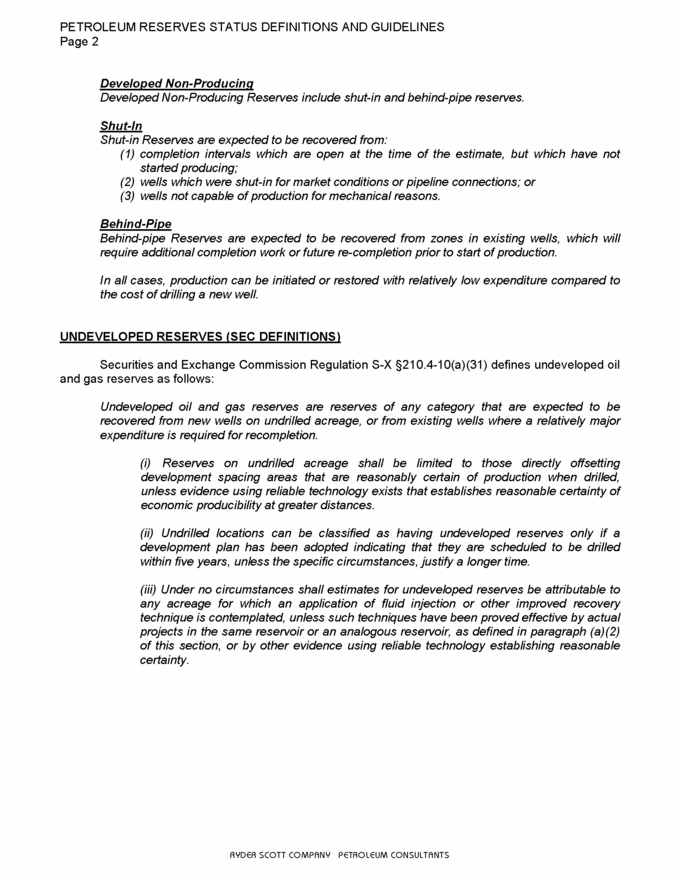
Table 1 RIVERCREST ROYALTIES, LLC ESTIMATED FUTURE RESERVES AND INCOME ATTRIBUTABLE TO CERTAIN ROYALTY INTERESTS UNESCALATED PARAMETERS AS OF DECEMBER 31, 2016 TOTAL PROVED SUMMARY RYDER SCOTT COMPANY PETR OLEUM CONSULTANTS REVENUE INTERESTS PRODUCT PRICES DISCOUNTED RYDER SCOTT COMPANY PETR OLEUM CONSULTANTS Gas FUTURE NET INCOME - M$ EXPENSE Oil/ Plant Oil/Cond. Plt. Prod. INTEREST Condensate Products Gas $/BBL $/BBL INITIAL FINAL REMARKS $/MCF COMPOUNDED MONTHLY 2.00% 298120.0 5.00% 225219.8 8.00% 181731.8 10.00% 161326.7 20.00% 104744.0 RYDER SCOTT COMPANY PETR OLEUM CONSULTANTS ESTIMATED 8/8 THIS PRODUCTION COMPANY NET PRODUCTION AVERAGE PRICES Number Oil/Cond. Period of Wells MBarrels Plant Prod. MBarrels Gas MMCF Oil/Cond. MBarrels Plant Prod. MBarrels Sales Gas MMCF Oil/Cond. $/BBL Plant Prod. $/BBL Gas $/MCF 12-17 45930. 171700.0 28590.5 948538.0 416.7 133.9 3292.5 39.23 14.68 2.00 12-18 45929. 158065.4 26558.0 883427.1 416.8 130.8 3203.2 39.11 14.71 2.01 12-19 45865. 149394.1 24980.0 854851.5 413.5 125.9 3186.7 39.05 14.72 1.99 12-20 45931. 140523.5 23705.9 845256.5 412.5 123.3 3246.2 38.99 14.72 1.99 12-21 45797. 132341.5 22373.0 808497.6 403.8 119.3 3149.6 38.98 14.72 1.98 12-22 45467. 123119.0 20333.3 730898.6 366.5 107.6 2831.4 39.02 14.76 1.99 12-23 45179. 114449.0 18468.7 658051.1 325.8 95.9 2514.7 39.09 14.78 2.00 12-24 44730. 107177.4 16914.7 600910.3 295.3 86.2 2261.0 39.13 14.82 2.00 12-25 44360. 100957.1 15703.6 555420.8 270.0 79.2 2075.4 39.16 14.82 2.00 12-26 43982. 95583.2 14542.4 513661.1 250.3 72.5 1902.9 39.19 14.84 2.01 12-27 43712. 91376.5 13518.5 476466.5 233.4 66.8 1747.5 39.20 14.86 2.01 12-28 43459. 86888.8 12594.7 443218.4 218.6 61.7 1615.3 39.22 14.88 2.02 12-29 42482. 81370.5 11727.2 411801.7 202.8 56.8 1492.4 39.21 14.91 2.02 12-30 41801. 76343.6 11005.6 384620.7 189.4 53.0 1396.1 39.23 14.85 2.02 12-31 41381. 71859.3 10329.0 358602.3 177.3 49.8 1302.5 39.24 14.86 2.02 Sub-Total 0. 1701148.9 271345.1 9474222.1 4592.7 1362.8 35217.5 39.12 14.77 2.00 Remainder 0. 1181764.9 136314.7 4187070.5 2617.1 619.3 15173.6 39.43 15.21 2.05 Total Future 0. 2882913.8 407659.8 13661292.5 7209.8 1982.1 50391.1 39.23 14.91 2.02 Cumulative 18585765.9 0.0 48840704.0 Ultimate 21468680.2 407659.7 62501994.5 COMPANY FUTURE GROSS REVENUE (FGR) - M$ PRODUCTION TAXES -M$ FGR AFTER PRODUCTION TAXES-M$ Period From Oil/Cond. From Plant Prod. From Gas Other Total Oil/Cond. Plant Prod. Gas 12-17 16348.9 1966.2 6572.7 0.0 24887.8 752.2 97.0 380.0 23658.6 12-18 16300.9 1923.9 6426.7 0.0 24651.5 749.3 96.0 368.3 23438.0 12-19 16148.4 1854.1 6339.9 0.0 24342.3 746.3 97.6 383.8 23114.6 12-20 16086.7 1816.0 6462.2 0.0 24364.9 749.6 96.9 396.4 23122.0 12-21 15740.8 1756.4 6243.8 0.0 23741.0 734.2 94.3 387.0 22525.4 12-22 14302.9 1588.1 5634.5 0.0 21525.5 662.2 84.5 349.1 20429.7 12-23 12736.9 1417.9 5018.4 0.0 19173.1 584.2 74.2 309.3 18205.5 12-24 11555.1 1277.0 4522.1 0.0 17354.2 525.9 66.4 277.2 16484.6 12-25 10573.2 1173.5 4156.1 0.0 15902.8 478.8 60.4 254.5 15109.1 12-26 9808.9 1075.5 3818.9 0.0 14703.4 441.9 55.3 233.7 13972.5 12-27 9151.1 992.3 3521.0 0.0 13664.4 410.6 50.8 220.6 12982.4 12-28 8572.3 917.9 3257.2 0.0 12747.3 383.4 46.8 204.1 12113.1 12-29 7951.1 846.5 3013.5 0.0 11811.1 354.6 42.9 189.2 11224.5 12-30 7430.3 787.4 2822.2 0.0 11039.9 331.4 39.4 178.8 10490.2 12-31 6957.5 739.6 2635.3 0.0 10332.4 310.3 36.7 167.5 9817.9 Sub-Total 179664.8 20132.5 70444.3 0.0 270241.6 8215.1 1039.3 4299.3 256688.0 Remainder 103202.7 9421.8 31137.9 0.0 143762.3 4366.4 446.3 1958.8 136990.7 Total Future 282867.5 29554.3 101582.3 0.0 414003.9 12581.5 1485.6 6258.1 393678.7 DEDUCTIONS - M$ FUTURE NET INCOME BEFORE INCOME TAXES-M$ Period Operating Costs Ad Valorem Taxes Development Costs Other Total Undiscounted Discounted @ 10.00 % Annual Cumulative 12-17 0.0 703.4 0.0 0.0 703.3 22955.3 22955.3 21896.7 12-18 0.0 701.3 0.0 0.0 701.3 22736.7 45692.0 19721.5 12-19 0.0 693.5 0.0 0.0 693.5 22421.1 68113.0 17676.6 12-20 0.0 696.8 0.0 0.0 696.8 22425.2 90538.2 16072.1 12-21 0.0 679.9 0.0 0.0 679.9 21845.5 112383.7 14234.9 12-22 0.0 613.8 0.0 0.0 613.8 19816.0 132199.6 11748.5 12-23 0.0 543.6 0.0 0.0 543.6 17661.9 149861.5 9517.1 12-24 0.0 490.8 0.0 0.0 490.8 15993.8 165855.3 7834.0 12-25 0.0 448.5 0.0 0.0 448.5 14660.6 180516.0 6527.8 12-26 0.0 414.6 0.0 0.0 414.6 13557.9 194073.8 5487.5 12-27 0.0 385.6 0.0 0.0 385.6 12596.8 206670.6 4634.8 12-28 0.0 359.9 0.0 0.0 359.9 11753.1 218423.7 3931.5 12-29 0.0 332.5 0.0 0.0 332.5 10892.0 229315.7 3312.2 12-30 0.0 308.9 0.0 0.0 308.9 10181.3 239497.1 2814.5 12-31 0.0 288.6 0.0 0.0 288.6 9529.2 249026.3 2394.8 Sub-Total 0.0 7661.7 0.0 0.0 7661.7 249026.3 249026.3 147804.3 Remainder 0.0 4046.8 0.0 0.0 4046.8 132943.9 381970.1 13522.4 Total Future 0.0 11708.5 0.0 0.0 11708.5 381970.2 381970.1 161326.8 These data are part of a Ryder Scott report and are subject to the conditions in the text of the report. These data were generated using the ARIES Program. RYDER SCOTT COMPANY PETR OLEUM CONSULTANTS
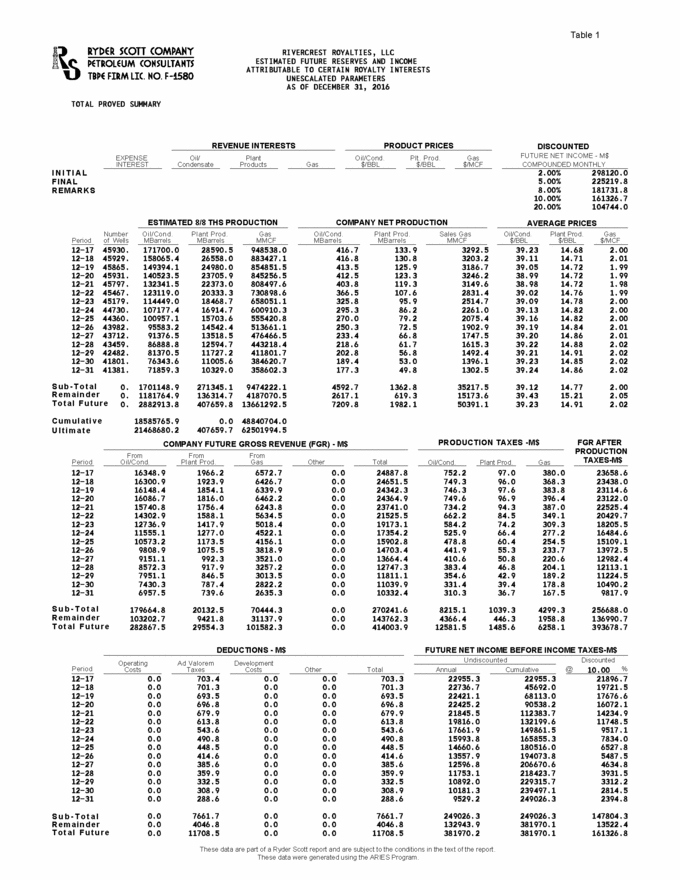
Table 2 RIVER CREST ROYALTIES, LLC ESTIMATED FUTURE RESERVES AND INCOME ATTRIBUTABLE TO CERTAIN ROYALTY INTERESTS UNESCALATED PARAMETERS AS OF DECEMBER 31, 2016 RYDER SCOTT COMPANY PETR OLEUM CONSULTANTS PROVED DEVELOPED PRODUCING SUMMARY REVENUE INTERESTS PRODUCT PRICES DISCOUNTED RYDER SCOTT COMPANY PETR OLEUM CONSULTANTS Gas FUTURE NET INCOME - M$ EXPENSE Oil/ Plant Oil/Cond. Plt. Prod. INTEREST Condensate Products Gas $/BBL $/BBL INITIAL FINAL REMARKS $/MCF COMPOUNDED MONTHLY 2.00% 207675.5 5.00% 160482.0 8.00% 131561.5 10.00% 117799.3 20.00% 79040.1 RYDER SCOTT COMPANY PETR OLEUM CONSULTANTS ESTIMATED 8/8 THIS PRODUCTION COMPANY NET PRODUCTION AVERAGE PRICES Number Oil/Cond. Period of Wells MBarrels Plant Prod. MBarrels Gas MMCF Oil/Cond. MBarrels Plant Prod. MBarrels Sales Gas MMCF Oil/Cond. $/BBL Plant Prod. $/BBL Gas $/MCF 12-17 45818. 170636.7 27733.4 929874.9 377.8 123.6 3082.1 39.28 14.74 1.99 12-18 45634. 154858.2 24603.9 831095.9 333.4 106.9 2687.9 39.33 14.84 2.00 12-19 45353. 142807.2 22286.6 753749.2 301.4 95.2 2397.1 39.36 14.89 2.01 12-20 45204. 132706.3 20415.4 691020.6 275.7 86.1 2168.0 39.39 14.93 2.01 12-21 44903. 123846.4 18813.1 637109.1 253.4 78.4 1976.4 39.40 14.96 2.01 12-22 44597. 115934.4 17416.8 589920.0 233.7 71.6 1811.0 39.41 14.97 2.02 12-23 44315. 108802.7 16173.8 547352.7 216.5 65.8 1663.8 39.42 14.96 2.02 12-24 43866. 102229.5 15056.7 509395.2 200.5 60.4 1532.9 39.42 14.96 2.02 12-25 43497. 96179.9 14042.2 474447.9 184.9 55.8 1417.5 39.43 14.96 2.02 12-26 43120. 90514.0 13113.6 442087.6 171.9 51.5 1311.6 39.43 14.96 2.02 12-27 42850. 85366.2 12255.4 411554.0 158.9 47.7 1206.5 39.43 14.95 2.03 12-28 42597. 80587.4 11466.3 384034.1 148.2 44.1 1115.9 39.43 14.96 2.04 12-29 41622. 75899.9 10719.4 358261.8 137.7 40.5 1030.0 39.42 14.99 2.04 12-30 40942. 71554.8 9997.3 333798.0 128.7 36.9 947.8 39.42 14.95 2.04 12-31 40525. 67655.7 9353.6 310966.0 120.2 34.2 872.0 39.42 14.97 2.05 Sub-Total 0. 1619579.4 243447.6 8204666.9 3242.9 998.7 25220.5 39.39 14.91 2.02 Remainder 0. 1151082.8 127615.4 3796514.0 1593.2 384.4 9101.2 39.47 15.20 2.09 Total Future 0. 2770662.1 371063.0 12001180.7 4836.2 1383.1 34321.7 39.41 14.99 2.03 Cumulative 18584694.8 0.0 48817262.6 Ultimate 21355358.2 371062.9 60818448.4 COMPANY FUTURE GROSS REVENUE (FGR) - M$ PRODUCTION TAXES -M$ FGR AFTER PRODUCTION TAXES-M$ Period From Oil/Cond. From Plant Prod. From Gas Other Total Oil/Cond. Plant Prod. Gas 12-17 14842.4 1821.2 6138.6 0.0 22802.2 670.9 90.4 353.7 21687.2 12-18 13112.4 1586.6 5375.9 0.0 20074.9 583.1 79.7 307.2 19104.9 12-19 11863.9 1418.1 4809.3 0.0 18091.3 523.0 73.6 285.9 17208.7 12-20 10858.3 1286.0 4358.6 0.0 16503.0 475.6 67.2 260.1 15700.0 12-21 9984.5 1173.4 3978.5 0.0 15136.5 435.2 61.8 237.4 14402.0 12-22 9210.1 1072.1 3650.6 0.0 13932.8 399.9 56.6 217.7 13258.6 12-23 8534.4 984.0 3356.6 0.0 12875.0 369.3 52.1 200.1 12253.6 12-24 7904.5 903.6 3094.3 0.0 11902.5 340.8 48.0 184.6 11329.1 12-25 7289.5 834.2 2864.1 0.0 10987.8 313.0 44.4 170.8 10459.6 12-26 6778.6 770.5 2655.0 0.0 10204.0 290.2 41.2 158.8 9713.8 12-27 6267.1 713.3 2454.5 0.0 9434.9 267.4 38.2 152.3 8977.0 12-28 5842.3 660.1 2271.9 0.0 8774.2 248.6 35.4 140.8 8349.5 12-29 5428.7 606.7 2099.8 0.0 8135.2 230.4 32.4 129.9 7742.4 12-30 5072.2 552.0 1936.7 0.0 7561.0 214.8 29.6 119.8 7196.7 12-31 4739.6 511.5 1785.2 0.0 7036.3 200.3 27.5 110.2 6698.4 Sub-Total 127728.5 14893.4 50829.7 0.0 193451.6 5562.7 778.1 3029.3 184081.6 Remainder 62881.7 5844.3 18991.9 0.0 87717.9 2471.1 310.9 1149.2 83786.7 Total Future 190610.3 20737.8 69821.6 0.0 281169.6 8033.8 1089.0 4178.5 267868.3 DEDUCTIONS - M$ FUTURE NET INCOME BEFORE INCOME TAXES-M$ Period Operating Costs Ad Valorem Taxes Development Costs Other Total Undiscounted Discounted @ 10.00 % Annual Cumulative 12-17 0.0 643.5 0.0 0.0 643.5 21043.7 21043.7 20094.9 12-18 0.0 561.7 0.0 0.0 561.7 18543.2 39586.9 16093.1 12-19 0.0 502.1 0.0 0.0 502.0 16706.7 56293.6 13179.5 12-20 0.0 455.3 0.0 0.0 455.3 15244.7 71538.3 10932.3 12-21 0.0 415.7 0.0 0.0 415.7 13986.3 85524.7 9117.8 12-22 0.0 381.6 0.0 0.0 381.6 12877.1 98401.7 7631.3 12-23 0.0 351.9 0.0 0.0 351.9 11901.6 110303.4 6411.8 12-24 0.0 324.9 0.0 0.0 324.9 11004.2 121307.5 5389.4 12-25 0.0 300.0 0.0 0.0 300.0 10159.6 131467.2 4523.5 12-26 0.0 278.6 0.0 0.0 278.6 9435.2 140902.4 3818.8 12-27 0.0 257.3 0.0 0.0 257.3 8719.7 149622.0 3208.5 12-28 0.0 239.4 0.0 0.0 239.4 8110.1 157732.1 2712.8 12-29 0.0 221.6 0.0 0.0 221.5 7520.9 165253.0 2287.0 12-30 0.0 205.6 0.0 0.0 205.6 6991.2 172244.2 1932.6 12-31 0.0 191.8 0.0 0.0 191.8 6506.6 178750.7 1635.2 Sub-Total 0.0 5330.9 0.0 0.0 5330.9 178750.7 178750.7 108968.6 Remainder 0.0 2471.5 0.0 0.0 2471.4 81315.3 260065.9 8830.9 Total Future 0.0 7802.4 0.0 0.0 7802.3 260066.0 260065.9 117799.5 These data are part of a Ryder Scott report and are subject to the conditions in the text of the report. These data were generated using the ARIES Program. RYDER SCOTT COMPANY PETR OLEUM CONSULTANTS
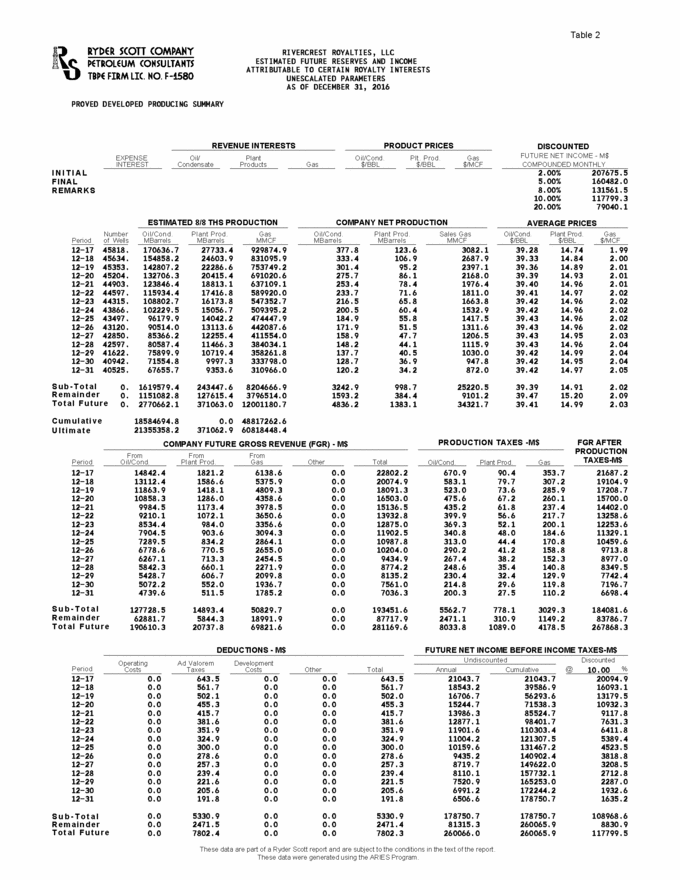
Table 3 RIVER CREST ROYALTIES, LLC ESTIMATED FUTURE RESERVES AND INCOME ATTRIBUTABLE TO CERTAIN ROYALTY INTERESTS UNESCALATED PARAMETERS AS OF DECEMBER 31, 2016 PROVED NON-PRODUCING SUMMARY RYDER SCOTT COMPANY PETR OLEUM CONSULTANTS REVENUE INTERESTS PRODUCT PRICES DISCOUNTED RYDER SCOTT COMPANY PETR OLEUM CONSULTANTS Gas FUTURE NET INCOME - M$ EXPENSE Oil/ Plant Oil/Cond. Plt. Prod. INTEREST Condensate Products Gas $/BBL $/BBL INITIAL FINAL REMARKS $/MCF COMPOUNDED MONTHLY 2.00% 2559.7 5.00% 1971.2 8.00% 1590.4 10.00% 1406.2 20.00% 889.2 RYDER SCOTT COMPANY PETR OLEUM CONSULTANTS Number Period of Wells ESTIMATED 8/8 THS PRODUCTION COMPANY NET PRODUCTION AVERAGE PRICES Oil/Cond. MBarrels Plant Prod. MBarrels Gas MMCF Oil/Cond. MBarrels Plant Prod. MBarrels Sales Gas MMCF Oil/Cond. $/BBL Plant Prod. $/BBL Gas $/MCF 12-17 6. 112.0 519.9 10360.8 0.6 2.4 51.5 40.50 12.36 1.80 12-18 25. 343.6 850.0 18351.9 2.4 3.4 86.1 35.57 12.34 1.79 12-19 25. 239.0 482.7 11057.9 2.1 1.9 54.6 34.41 12.32 1.78 12-20 27. 281.8 344.1 8220.6 4.1 1.4 43.9 34.14 12.33 1.79 12-21 27. 201.6 270.7 6532.3 3.6 1.1 34.9 35.55 12.30 1.78 12-22 26. 161.9 224.8 5467.0 2.9 0.9 29.5 35.65 12.29 1.78 12-23 27. 161.8 303.8 7018.3 2.6 1.6 42.9 36.03 12.34 1.81 12-24 27. 131.7 223.9 5311.7 2.2 1.1 31.6 35.87 12.32 1.80 12-25 27. 134.3 259.5 5993.5 2.1 1.4 38.0 36.12 12.34 1.81 12-26 25. 111.4 194.3 4521.2 1.8 1.0 28.7 35.92 12.33 1.81 12-27 25. 96.7 156.8 3700.8 1.6 0.8 23.6 35.80 12.32 1.80 12-28 25. 86.2 132.1 3160.6 1.4 0.7 20.2 35.71 12.31 1.79 12-29 25. 77.7 112.8 2715.3 1.3 0.6 17.3 35.65 12.32 1.81 12-30 24. 97.7 199.7 4449.8 1.5 1.3 32.4 36.42 12.39 1.87 12-31 23. 105.7 242.9 5267.2 1.5 1.7 40.2 36.81 12.40 1.88 Sub-Total 0. 2343.1 4518.1 102129.0 31.6 21.4 575.5 35.63 12.34 1.81 Remainder 0. 1034.8 2399.6 49132.3 11.3 11.2 274.9 35.52 12.41 1.89 Total Future 0. 3377.8 6917.7 151261.2 42.9 32.7 850.4 35.60 12.37 1.83 Cumulative 1067.8 0.0 23447.8 Ultimate 4445.6 6917.7 174709.0 COMPANY FUTURE GROSS REVENUE (FGR) - M$ PRODUCTION TAXES -M$ FGR AFTER PRODUCTION TAXES-M$ Period From Oil/Cond. From Plant Prod. From Gas Other Total Oil/Cond. Plant Prod. Gas 12-17 22.8 29.6 92.7 0.0 145.1 2.7 0.4 8.0 134.0 12-18 86.5 41.9 154.2 0.0 282.6 9.5 0.5 11.7 260.8 12-19 73.2 23.7 97.5 0.0 194.4 8.1 0.3 6.9 179.1 12-20 138.3 17.2 78.6 0.0 234.1 13.8 0.2 5.3 214.8 12-21 128.0 13.6 62.3 0.0 203.9 10.7 0.2 4.1 188.9 12-22 102.6 11.3 52.5 0.0 166.4 8.5 0.1 3.4 154.4 12-23 94.1 19.9 77.7 0.0 191.7 8.1 0.3 5.7 177.6 12-24 78.6 13.6 56.9 0.0 149.1 6.7 0.2 4.0 138.3 12-25 74.1 17.8 68.9 0.0 160.8 6.6 0.2 5.1 148.9 12-26 63.9 12.7 51.9 0.0 128.5 5.6 0.2 3.7 119.0 12-27 56.8 9.9 42.4 0.0 109.1 4.9 0.1 3.0 101.2 12-28 51.5 8.2 36.3 0.0 96.0 4.4 0.1 2.9 88.5 12-29 47.1 6.9 31.4 0.0 85.3 4.0 0.1 2.6 78.6 12-30 52.9 16.6 60.5 0.0 129.9 4.9 0.2 5.1 119.7 12-31 54.8 21.6 75.5 0.0 151.9 5.3 0.3 6.5 139.9 Sub-Total 1125.1 264.6 1039.2 0.0 2428.8 103.8 3.4 78.0 2243.6 Remainder 401.1 139.6 520.0 0.0 1060.7 41.0 1.8 43.8 974.0 Total Future 1526.1 404.1 1559.2 0.0 3489.5 144.8 5.3 121.8 3217.6 DEDUCTIONS - M$ FUTURE NET INCOME BEFORE INCOME TAXES-M$ Period Operating Costs Ad Valorem Taxes Development Costs Other Total Undiscounted Discounted @ 10.00 % Annual Cumulative 12-17 0.0 1.4 0.0 0.0 1.4 132.6 132.6 123.3 12-18 0.0 4.8 0.0 0.0 4.8 256.1 388.7 223.2 12-19 0.0 3.9 0.0 0.0 3.9 175.2 563.9 137.9 12-20 0.0 5.8 0.0 0.0 5.8 209.0 772.9 149.7 12-21 0.0 4.9 0.0 0.0 4.9 183.9 956.8 120.1 12-22 0.0 4.0 0.0 0.0 4.0 150.4 1107.2 89.2 12-23 0.0 3.8 0.0 0.0 3.8 173.8 1280.9 93.6 12-24 0.0 3.2 0.0 0.0 3.2 135.1 1416.0 66.2 12-25 0.0 3.1 0.0 0.0 3.1 145.8 1561.8 64.9 12-26 0.0 2.6 0.0 0.0 2.6 116.4 1678.2 47.2 12-27 0.0 2.3 0.0 0.0 2.3 98.8 1777.0 36.4 12-28 0.0 2.1 0.0 0.0 2.1 86.4 1863.4 28.9 12-29 0.0 1.9 0.0 0.0 1.9 76.7 1940.1 23.3 12-30 0.0 2.2 0.0 0.0 2.2 117.4 2057.6 32.5 12-31 0.0 2.4 0.0 0.0 2.4 137.6 2195.1 34.6 Sub-Total 0.0 48.5 0.0 0.0 48.5 2195.1 2195.1 1271.0 Remainder 0.0 18.7 0.0 0.0 18.8 955.2 3150.4 135.2 Total Future 0.0 67.2 0.0 0.0 67.2 3150.4 3150.4 1406.2 These data are part of a Ryder Scott report and are subject to the conditions in the text of the report. These data were generated using the ARIES Program. RYDER SCOTT COMPANY PETR OLEUM CONSULTANTS

Table 4 RIVER CREST ROYALTIES, LLC ESTIMATED FUTURE RESERVES AND INCOME ATTRIBUTABLE TO CERTAIN ROYALTY INTERESTS UNESCALATED PARAMETERS AS OF DECEMBER 31, 2016 PROVED UNDEVELOPED SUMMARY RYDER SCOTT COMPANY PETR OLEUM CONSULTANTS REVENUE INTERESTS PRODUCT PRICES DISCOUNTED RYDER SCOTT COMPANY PETR OLEUM CONSULTANTS Gas FUTURE NET INCOME - M$ EXPENSE Oil/ Plant Oil/Cond. Plt. Prod. INTEREST Condensate Products Gas $/BBL $/BBL INITIAL FINAL REMARKS $/MCF COMPOUNDED MONTHLY 2.00% 87884.8 5.00% 62766.7 8.00% 48580.0 10.00% 42121.1 20.00% 24814.6 RYDER SCOTT COMPANY PETR OLEUM CONSULTANTS Number Period of Wells ESTIMATED 8/8 THIS PRODUCTION COMPANY NET PRODUCTION AVERAGE PRICES Oil/Cond. MBarrels Plant Prod. MBarrels Gas MMCF Oil/Cond. MBarrels Plant Prod. MBarrels Sales Gas MMCF Oil/Cond. $/BBL Plant Prod. $/BBL Gas $/MCF 12-17 106. 951.3 337.2 8302.3 38.3 7.9 158.9 38.72 14.52 2.15 12-18 270. 2863.5 1104.0 33979.5 80.9 20.5 429.2 38.33 14.43 2.09 12-19 486. 6347.8 2210.7 90044.1 110.0 28.8 734.9 38.28 14.32 1.95 12-20 701. 7535.3 2946.4 146015.2 132.8 35.8 1034.3 38.33 14.32 1.96 12-21 867. 8293.5 3289.1 164856.0 146.8 39.8 1138.3 38.35 14.31 1.94 12-22 844. 7022.6 2691.7 135512.1 129.9 35.1 990.9 38.40 14.39 1.95 12-23 837. 5484.5 1991.1 103679.6 106.7 28.6 808.0 38.51 14.50 1.96 12-24 837. 4816.1 1634.1 86203.3 92.6 24.7 696.5 38.59 14.57 1.97 12-25 837. 4642.9 1401.9 74979.6 83.0 22.0 619.9 38.65 14.62 1.97 12-26 837. 4957.8 1234.5 67052.4 76.6 19.9 562.6 38.71 14.67 1.98 12-27 837. 5913.6 1106.2 61211.6 72.9 18.3 517.5 38.78 14.72 1.98 12-28 837. 6215.3 996.3 56023.8 69.0 16.9 479.1 38.83 14.76 1.98 12-29 835. 5392.9 895.0 50824.3 63.7 15.7 445.1 38.85 14.80 1.98 12-30 834. 4691.1 808.6 46372.7 59.3 14.7 416.0 38.88 14.84 1.98 12-31 833. 4097.9 732.5 42368.9 55.6 13.9 390.3 38.91 14.87 1.98 Sub-Total 0. 79226.2 23379.4 1167425.3 1318.2 342.6 9421.5 38.55 14.52 1.97 Remainder 0. 29647.1 6299.7 341423.2 1012.5 223.7 5797.5 39.43 15.37 2.01 Total Future 0. 108873.3 29679.1 1508848.5 2330.7 566.3 15219.0 38.93 14.85 1.98 Cumulative 0.0 0.0 0.0 Ultimate 108873.3 29679.1 1508848.5 COMPANY FUTURE GROSS REVENUE (FGR) - M$ PRODUCTION TAXES -M$ FGR AFTER PRODUCTION TAXES-M$ Period From Oil/Cond. From Plant Prod. From Gas Other Total Oil/Cond. Plant Prod. Gas 12-17 1483.7 115.4 341.4 0.0 1940.5 78.6 6.2 18.3 1837.4 12-18 3102.0 295.4 896.5 0.0 4294.0 156.7 15.8 49.3 4072.2 12-19 4211.3 412.3 1433.0 0.0 6056.6 215.2 23.6 91.0 5726.7 12-20 5090.1 512.8 2025.0 0.0 7627.8 260.3 29.5 131.0 7207.1 12-21 5628.2 569.5 2203.0 0.0 8400.7 288.3 32.3 145.5 7934.5 12-22 4990.2 504.8 1931.3 0.0 7426.3 253.8 27.7 128.0 7016.8 12-23 4108.3 414.0 1584.1 0.0 6106.5 206.9 21.8 103.5 5774.3 12-24 3571.9 359.7 1370.9 0.0 5302.6 178.4 18.2 88.7 5017.2 12-25 3209.6 321.4 1223.1 0.0 4754.1 159.2 15.8 78.6 4500.6 12-26 2966.5 292.4 1112.0 0.0 4370.9 146.1 13.9 71.1 4139.7 12-27 2827.1 269.1 1024.1 0.0 4120.3 138.3 12.5 65.3 3904.2 12-28 2678.5 249.6 949.0 0.0 3877.1 130.3 11.3 60.4 3675.1 12-29 2475.4 232.9 882.4 0.0 3590.7 120.2 10.4 56.7 3403.4 12-30 2305.2 218.8 825.0 0.0 3349.0 111.7 9.6 53.8 3173.8 12-31 2163.1 206.5 774.5 0.0 3144.1 104.7 8.9 50.9 2979.6 Sub-Total 50811.2 4974.5 18575.4 0.0 74361.1 2548.6 257.7 1192.0 70362.8 Remainder 39919.8 3437.9 11626.0 0.0 54983.7 1854.3 133.6 765.8 52230.0 Total Future 90731.0 8412.4 30201.5 0.0 129344.8 4402.9 391.3 1957.8 122592.8 DEDUCTIONS - M$ FUTURE NET INCOME BEFORE INCOME TAXES-M$ Period Operating Costs Ad Valorem Taxes Development Costs Other Total Undiscounted Discounted @ 10.00 % Annual Cumulative 12-17 0.0 58.4 0.0 0.0 58.4 1779.0 1779.0 1678.5 12-18 0.0 134.8 0.0 0.0 134.8 3937.4 5716.4 3405.2 12-19 0.0 187.6 0.0 0.0 187.6 5539.2 11255.5 4359.1 12-20 0.0 235.7 0.0 0.0 235.7 6971.5 18227.0 4990.1 12-21 0.0 259.3 0.0 0.0 259.3 7675.2 25902.2 4997.0 12-22 0.0 228.2 0.0 0.0 228.2 6788.5 32690.8 4028.1 12-23 0.0 187.8 0.0 0.0 187.8 5586.5 38277.2 3011.6 12-24 0.0 162.7 0.0 0.0 162.7 4854.6 43131.8 2378.4 12-25 0.0 145.4 0.0 0.0 145.4 4355.2 47487.0 1939.4 12-26 0.0 133.4 0.0 0.0 133.4 4006.3 51493.3 1621.5 12-27 0.0 126.0 0.0 0.0 125.9 3778.3 55271.6 1389.9 12-28 0.0 118.4 0.0 0.0 118.4 3556.6 58828.2 1189.8 12-29 0.0 109.0 0.0 0.0 109.0 3294.4 62122.6 1001.8 12-30 0.0 101.1 0.0 0.0 101.1 3072.7 65195.4 849.4 12-31 0.0 94.5 0.0 0.0 94.5 2885.1 68080.5 725.0 Sub-Total 0.0 2282.3 0.0 0.0 2282.3 68080.5 68080.5 37564.8 Remainder 0.0 1556.6 0.0 0.0 1556.6 50673.5 118754.0 4556.3 Total Future 0.0 3838.8 0.0 0.0 3838.9 118753.9 118754.0 42121.1 These data are part of a Ryder Scott report and are subject to the conditions in the text of the report. These data were generated using the ARIES Program. RYDER SCOTT COMPANY PETR OLEUM CONSULTANTS
